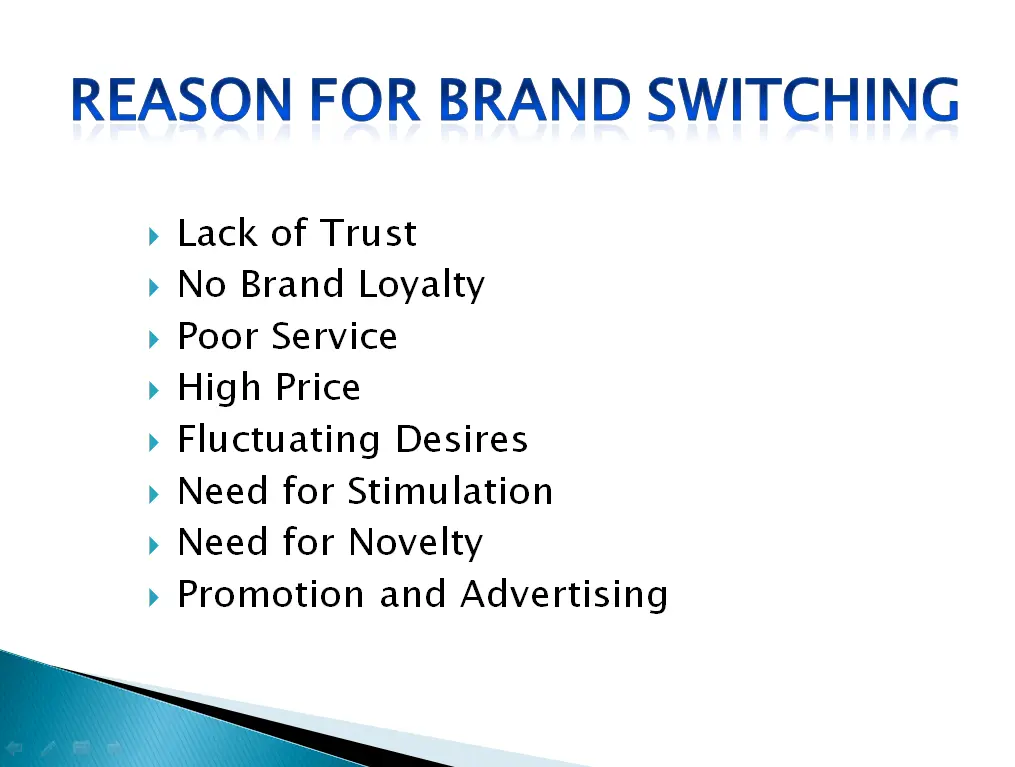Table of Contents:-
- Brand Switching
- Various Reasons for brand switching
Brand switching
Brand switching behaviour can be influenced by both intrinsic and extrinsic factors. Intrinsic factor refers to a consumer’s internal motivation, namely the consumer’s desire to experiment with new brands. While the extrinsic factors come from outside, they are external stimuli such as free samples, discounts, and lower prices. Intrinsic factors may include a desire for novelty or a need for variety in one’s purchasing habits. On the other hand, extrinsic factors may be driven by economic incentives or promotional offers.
Businesses need to understand the reasons behind brand switching behaviour to effectively retain customers and attract new ones. By analyzing both intrinsic and extrinsic factors, businesses can tailor their marketing strategies to skillfully meet the needs and preferences of their target customers.
According to Dharmmesta, “the stimulation marketing on the consumer will activate his cognitive stage, which is highly susceptible to the brand switching decision. Those empirical findings define brand switching as a purchasing pattern that is indicated by the change or shift from one brand to another brand.”
Several factors influence a consumer’s decision to switch brands. These factors include inconvenience, pricing policies, core service failures, unresponsive employees, competition offering more appealing services, and ethical concerns.
Reason for Brand Switching
There are some reasons behind the brand switching decision, which are as follows:

1) Lack of Trust
It is considered an important factor in building relationships between the customers and the organization. It is a trust which makes customers closer to the organisation. Trust is built when an organisation promises to provide quality service to customers and it is successful to provide them with that service quality then trust is built if the customer does not have trust in the brand. He will try another product.
2) No Brand Loyalty
Brand Loyalty has become a very important factor for marketers and consumer researchers. The study suggests that an organisation which is having so many loyal customers will lead to greater share and high profit. Brand loyal customers will engage in positive Word of Mouth for the company and even not accept the marketing strategies of competitors. If the customer is not loyal towards the brand, he will switch brands every time.
3) Poor Service
The reasons why customers switch from one business to another can vary depending on the industry. But in most cases, poor service quality is the primary reason for it. One common reason for customer abandonment is dissatisfaction with the quality of a product or service and it is not satisfying their needs, forcing them to switch to a competitor’s offering instead. Or they might abandon your business because they believe the poor service is not worth what the company is charging. In this case, they may choose to forego the service you are offering instead of selecting a competitor.
4) High Price
Price is one of the important factors which plays a vital role in brand switching, it is the amount which a consumer pays for any product or service while purchasing or using that product or service. If service providers charge price sensible and give better services then it will create customer satisfaction and very less consumers will switch to another brand. As price fairness is an extremely significant concern that leads to satisfaction. That means the price has a positive impact on brand switching. If the service providers charge a high price then more consumers will switch to another brand.
5) Fluctuating Desires
The fortunes of established brands are driven by consumers’ fluctuating desires, not by changed perceptions. When a consumer switches around within a set of brands, it is because her fluctuating desires temporarily alter how important it is that she receives the benefits of one brand versus another. After a product has been utilized, a consumer’s perception of it typically remains unchanged. However, their desires for the perceived benefits of competing brands often fluctuate, leading to brand switching
6) Need for Stimulation (Active, External):
Individuals often seek variety & difference out of a need for stimulation. Variety-seeking behaviour may be a prime reason for brand switching or impulse purchasing. The desire for stimulation is not a constant but rather changes over time in a curvilinear fashion. This means that people who experience rapid change may eventually become satiated and desire stability, whereas people in stable environments become bored and desire change.
7) Need for Novelty
One often seeks variety and difference simply out of the need for novelty. Marketers refer to this kind of motive as variety-seeking behaviour. This is the primary reason for brand switching and impulse purchasing. The need for novelty changes with time. Consumers who experience rapid change often become satiated and seek stability, while those in unchanging environments tend to become bored and seek change.
8) Promotion and Advertising
Promotion and advertising are positively related to brand switching, and their effects on brand switching may vary across different age groups and product categories. Younger customers are often more susceptible to the influence of promotions and advertising for soft drink products, while middle-aged customers tend to be more responsive to promotions and advertising for skincare products.
Related Articles:
- nature of marketing
- difference between questionnaire and schedule
- features of marginal costing
- placement in hrm
- limitations of marginal costing
- nature of leadership
- difference between advertising and personal selling

You may also like:
Impact of Globalisation on International Business
Importance of International Business Environment
Complexities of International Business
Multinational Companies Meaning and Definition
Modes of Entry into International Business
Impact of media on consumer Behaviour
Impact of social media on consumer behaviour
Factors Influencing Consumer Behaviour
PsychoanalyticTheory of Perception
Difference between consumer and customer
